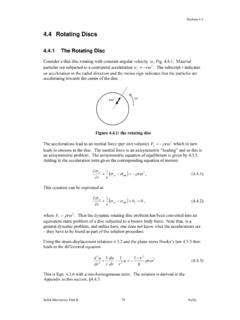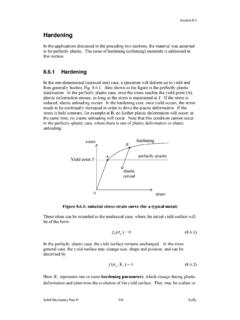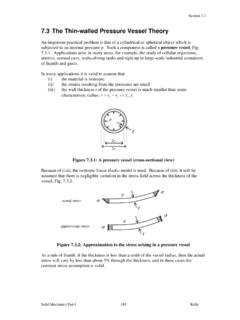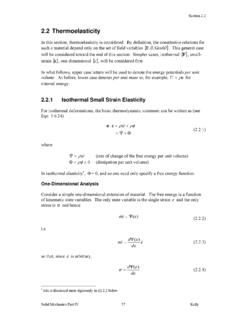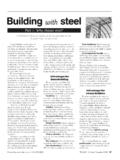Transcription of 10.2 Examples and Applications of Viscoelastic Materials
1 Section Solid Mechanics Part I Kelly Examples and Applications of Viscoelastic Materials Some of the properties of Viscoelastic Materials are their ability to creep, recover, undergo stress relaxation and absorb energy. Some Examples of these phenomena are discussed in this section1. Creep and Recovery The disks in the human spine are Viscoelastic . Under normal body weight, the disks creep, that is they get shorter with time. Lying down allows the spinal disks to recover and this means that most people are taller in the morning than in the evening.
2 Astronauts have gained up to 5cm in height under near-zero gravity conditions. Skin tissue is Viscoelastic . This can be seen by pinching the skin at the back of the hand; it takes time to recover back to its original flat position. The longer the skin is held in the pinched position, the longer it takes to recover. The more rapidly it is pinched, the less time it takes to recover it behaves more elastically . Skin is an ageing material , that is, its physical properties change over time. Younger skin recovers more rapidly than older skin. Wood is Viscoelastic . The beams of old wooden houses can often be seen to sag, but this creeping under the weight of the roof and gravity can take many decades or centuries to be noticeable.
3 Concrete and soils are other Materials which creep, as is ice, which has consequences for glacial movements. Materials which behave elastically at room temperature often attain significant Viscoelastic properties when heated. Such is the case with metal turbine blades in jet engines, which reach very high temperatures and need to withstand very high tensile stresses. Conventional metals can creep significantly at high temperatures and this has led to the development of creep-resistant alloys; turbine blades are now often made of so-called superalloys which contain some or all of nickel, cobalt, chromium, aluminium, titanium, tungsten and molybdenum.
4 Creep is also one of the principal causes of failure in the electric light bulb. The filaments in light bulbs are made of tungsten, a metal with a very high melting point (>3300oC); this is essential because the filament needs to be electrically heated to a temperature high enough for light emission ( 2000oC). If the filament creeps too much it sags and its coils touch each other, leading to a localised short circuit. Light bulbs last longer if the temperature is reduced, as in dimmed lights. Creep can also be reduced by adding potassium bubbles to the tungsten. Polymer foams used in seat cushions creep, allowing progressive conformation of the cushion to the body shape.
5 These cushions help reduce the pressures on the body and are very helpful for people confined to wheelchairs or hospital beds for lengthy periods. 1 quite a few of the Applications and Examples here are taken from Viscoelastic Solids, by R. S. Lakes, CRC Press, 1999 Section Solid Mechanics Part I Kelly 290 They often have to be replaced after about 6 months because creep causes them to become more dense and stiff. A newly born baby s head is Viscoelastic and its ability to creep and recover helps in the birthing process.
6 Also, if a baby lies in one specific position for long, for example the same way of sleeping all the time, its head can become misshapen due to creep deformation. A baby's skull becomes more solid after about a year. Viscoelasticity is also involved in the movement and behaviour of the tectonic plates, the plates which float on and travel independently over the mantle of the earth, and which are responsible for earthquakes, volcanoes, etc. Stress Relaxation Guitar strings are Viscoelastic . When tightened they take up a tensile stress. However, when fixed at constant length (strain), stress relaxation occurs.
7 The speed of sound in a string is / c, where is the stress and the density. The frequency is /cf , where is the wavelength. The length of the string L is equal to half the wavelength: )2/(/Lf . The reduction in stress thus implies a reduction in frequency and a lowering of pitch the guitar goes out of tune. The strings of a Classical Guitar are made of Nylon, a synthetic polymer. The great classical guitarists of the 19th Century did not have Nylon, invented in 1938, but used Catgut strings, usually made from the intestines of sheep; Catgut is a natural polymer. Metal guitar strings do not go out of tune so easily since metals are less Viscoelastic than polymers.
8 Energy Absorption Tall buildings vibrate when dynamically loaded by wind or earthquakes. Viscoelastic Materials have the property of absorbing such vibrational energy damping the vibrations. Viscoelastic dampers are used in some tall buildings, for example in the Columbia Center in Seattle, in which the dampers consist of steel plates coated with a Viscoelastic polymer compound - the dampers are fixed to some of the diagonal bracing members. Sometimes it is necessary to control vibrations but the use of a polymer is inappropriate - in this case it is necessary to use some other material with good vibration-control properties.
9 A good example is the use of copper-manganese alloy to reduce vibration and noise from naval ship propellers. This alloy has also been used in pneumatic rock crushers. Zinc is also relatively Viscoelastic for a metal and zinc-aluminium alloys are used in pneumatic drills - the alloy damps the vibrations and makes it a little less uncomfortable for anyone holding a pneumatic drill. Viscoelastic Materials are also used to line the gloves worn by people working with pneumatic drills and jackhammers. Helicopters make a lot of noise, which comes mainly from the turbine (rotary engine) and gears, but it is usually exacerbated by resonance of the fuselage skin.
10 Acoustic blankets consisting of a layer of fibreglass sandwiched between layers of vinyl cloth, placed inside the fuselage, can reduce the noise. Sikorsky, in their HH-53C rescue helicopter, coated a Section Solid Mechanics Part I Kelly 291small portion of the fuselage skin with damping treatments, which helped reduce the high-frequency noise in the cabin by 10 dB. In quartz watches, vibrations are set up in quartz crystal at ultrasonic frequency ( kHz). The vibrations are then used to generate periodic signals, which may be divided into intervals of time, like the second.

